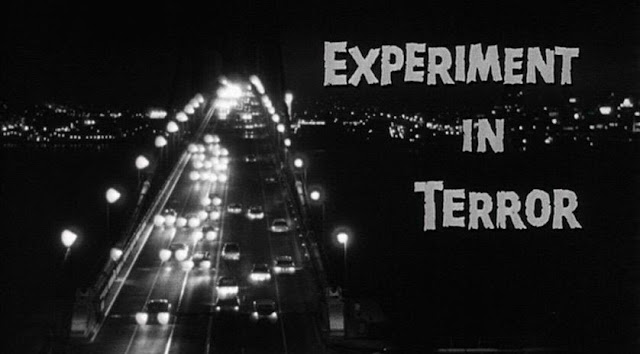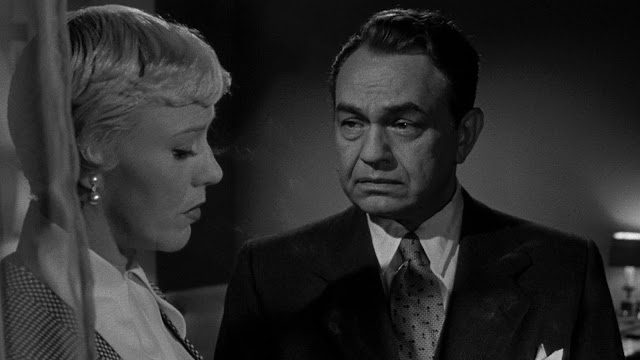 |
| Lee Remick is terrorized and toyed with in 1962's "Experiment in Terror." |
In
the wake of 1960’s Psycho, a number
of modern thrillers were now distinctly on the dark side. One of the most
stylish and disturbing Hitchcock prototypes was 1962’s Experiment in Terror, Blake Edwards’ rare film foray into suspense.
The
premise of Experiment in Terror is
simple: psycho villain Garland “Red” Lynch coerces teller Kelly Sherwood to
steal a bundle from her bank employer. If not, Lynch threatens to kill Kelly
and her teen sister. It all sounds simple, but there are some sick twists along
the way. The film’s story was written by husband and wife team, The Gordons. Another
talent that gets interesting billing is Ross Martin, as the villain, who only gets
his name at the end credits.
 |
| Ross Martin's villain 'Red' is slowly revealed as "Experiment in Terror" progresses. |
This
was Blake Edwards and Lee Remick’s first collaboration, just before their
classic, The Days of Wine and Roses. After
grueling roles as the targeted heroine in Experiment
in Terror and alcoholic wife in The
Days of Wine and Roses, Edwards should’ve invited Remick to star in one of
his many comedies!
 |
| Ross Martin's maniac ain't playin' as he catches Lee Remick's Kelly calling the FBI. |
Like
Hitchcock’s suspense films, Experiment in
Terror is leisurely paced, by today’s attention span-challenged standards.
Edwards’ films are often long, but the night driving opening scene in San Fran,
with Henry Mancini’s languid score, sets the eerie mood. At just over two
hours, Experiment could’ve been closer
to the standard 1 hour and 45 min. mark, yet keeps the viewer intrigued.
 |
| "Experiment in Terror" has an dreamy opening score by Henry Mancini. |
Philip
H. Lathrop’s cinematography is atmospheric, with deep shadows and strategic
light for the evening scenes, in sharp contrast to the blinding daytime scenes
in sunny CA. Experiment in Terror’s
great camera angles and point of view are striking and contribute much of the
suspense. Lathrop was a frequent Blake Edwards collaborator and also
photographed another mid-century suspense classic, Orson Welles’ Touch of Evil.
 |
| "Witness for the Prosecution" lighting? Lee Remick as Kelly, "Experiment in Terror." |
One
thing I admire about Blake Edwards’ work is that his approach to dramatic material
was adult and forward-thinking, especially for the era. For instance, though
the targeted heroine and the FBI agent become close while trying to capture the
villain, they don’t fall in love. Also admirable is that the heroine Kelly
Sherwood is not a cowering victim, though rightfully terrified of the creepy
bad guy. Kelly is a bright, independent, stand-up person who’s not afraid to
hold her own against the domineering villain. This is emphasized with Lee
Remick’s performance. Remick had that gentle side, with those huge, child-like
baby blues that made her perfect for projecting fear, in such movies as this, The Running Man, No Way to Treat a Lady, and The
Omen. She also originated and won a Tony for the Broadway version of Wait Until Dark. Remick’s sass, warmth, strength,
and intelligence are put to good effect in this thriller.
 |
| Lee Remick as Kelly, would-be bank robber, brings to mind Hitchcock's "Marnie." |
During
the scenes where Kelly goes along with the bank heist at the villain’s behest,
I kept thinking what a marvelous Marnie
Lee Remick would have made, instead of non-actress Tippi Hedren. Lee was also six
years younger than Tippi, and more age appropriate to emotionally stunted
Marnie. I’ve wondered why Hitch didn’t use Lee in the first half of the ‘60s,
when he was often looking for his next Hitchcock blonde.
 |
| Lee Remick's heroine hides in the bathroom, just like Tippi Hedren's "Marnie." |
Glenn
Ford, not one of my favorite actors, is low-key but straightforward as FBI
agent John Ripley. One thing I like about Ford is that he was comfortable
enough not to act the macho showboat, like Kirk Douglas or Burt Lancaster, or
the younger anti-heroes of the ‘60s. Ford comes across like an intelligent,
decent guy and his character doesn’t have all the answers.
 |
| Glenn Ford is solid as the FBI man, but what's up with his greasy comb-forward?! |
Ross
Martin as psychotic villain Garland “Red” Lynch is terrifying and terrific. His
character’s penchant for disguise is a precursor to Martin’s later role as
Artemis Gordon on The Wild, Wild West.
I, along with others on the Internet, have found that his disguise in the
finale must have inspired the Unabomber! Martin is utterly creepy, pathetic,
sadistically funny, and compelling. Any other year, Ross Martin would have been
a best supporting actor nominee shoo-in. But 1962 was a strong performance
movie year, and Victor Buono got the suspense movie nod, as Edward in Whatever Happened to Baby Jane? Given
the Buono played the same type for his entire career, Ross’ virtuoso turn as
‘Red’ was more deserving, in retrospect. Martin was an early Blake Edwards
favorite during his previous TV tenure, who gave Ross his first substantial
film role as the asthmatic killer in Experiment
in Terror. Soon after, Edwards cast him another scene-stealing role, in The Great Race.
 |
| Ross Martin, as 'Red' Lynch, lurks among the mannequins in "Experiment in Terror." |
Anita
Loo, as Susie Soong, is intriguing as the Asian girlfriend of Ross Martin’s
“Red.” Her character is ambiguous as to how close they are and how much she
knows about his other life. How adult of Edwards to show that the villain has a
human side, in this case, helping the woman’s son with medical issues. Also
realistic is Soong’s denial and defiant attitude about helping the Feds, only looking
from her own personal point of view. Loo plays the enigmatic character in an
understated way that is both empathetic and yet rather chilling.
 |
| Anita Loo is the killer's mystery woman, with Glenn Ford, in "Experiment in Terror." |
Stefanie
Powers is nearly unrecognizable as a baby-faced teen, as Toby Sherwood, Kelly’s
kid sister. She is sincere and holds her own during some of the later
terrifying scenes involving her. Ned Glass is a scene stealer as always, as
“Popcorn,” the genial, movie-loving informant. Patricia Huston is Nancy Ashton,
a target of the villain’s wrath. Her character is touchingly stoic, as she
reaches out for help, but too late. Amusing that the villain’s last name is
Lynch and that the heroine lived near Twin Peaks in San Francisco—no coffee
loving cops, however. And I love the stars oh so ‘60s names of the sisters,
Kelly and Toby Sherwood!
 |
| Stefanie Powers is nearly unrecognizable as the kid sister, in "Experiment in Terror." |
Experiment in Terror
used to be on TV a lot when I was a kid, but I hadn’t watched it as an adult,
until just recently. Experiment is an
early modern thriller that still chills.
Here’s
the movie that made Lee Remick a star, my look at Anatomy of a Murder, filmed entirely in Upper MI, my home! https://ricksrealreel.blogspot.com/2016/08/anatomy-of-murder-film-fiction-draws.html
FYI: I put all the movie overflow on my public FB movie
page.
Check it out & join!
https://www.facebook.com/groups/178488909366865/
 |
| Does Ross Martin's psycho in "Experiment in Terror" remind you of anyone? |








